The AHS Blog

Venner chance comes along, take it
This post was written by James Nye
In November, David Rooney mentioned the Venner time switches in telephone kiosks. This prompted wheels to whir in my brain and I went hunting in my ‘reserve collection’ for something I acquired many years ago, by chance.

Unfortunately, the history of the firm as presently researched is somewhat sketchy. If anyone is interested in doing so, here is a workshop ledger from Venner, c.1934 onwards. It is a systematically arranged in-house descriptive and photographic catalogue of several hundred ‘specials’, produced from the early 1930s to the late 1940s. Every item had a unique code, all indexed, and most items have a fine quality photograph, with a scale included – these people meant business, and they were perfectionists.
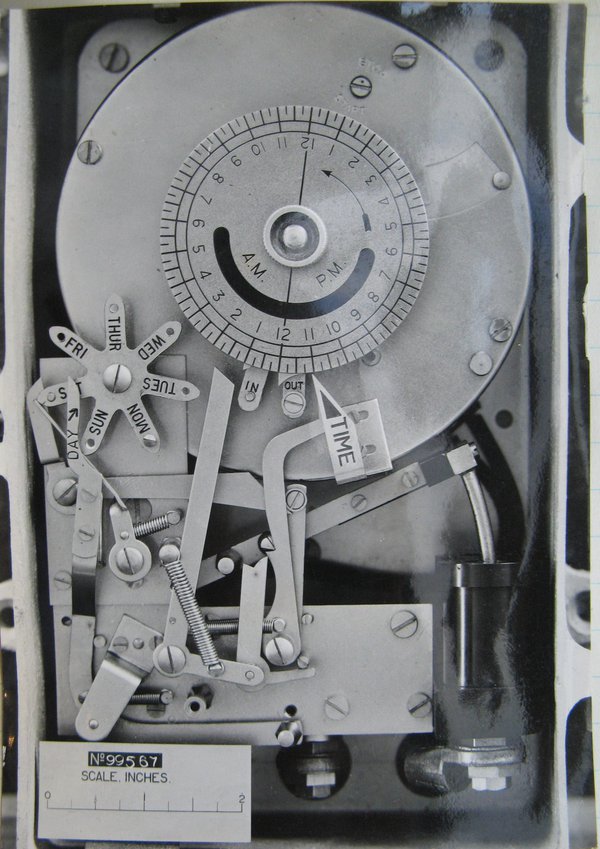
Venner master clocks are finely finished, but this meticulous approach extended to machinery that would probably be invisible throughout its life. As often in the mid-twentieth century, when electro-mechanics were relied on and before integrated circuits, the requirements for accurate timing and switching, perhaps with some programming, necessitated significant mechanical and engineering ingenuity. It is telling that each description starts with ‘special’.

From 1938, we learn that the Royal Physical Society needed a system for lecturers, which would switch a green lamp to amber, one minute before time, and then to red when their allotted slot expired.

In all it is a marvellous piece of ephemera and testament to the very high standards set by manufacturers of mysterious clockwork black boxes which are worthy of closer study.
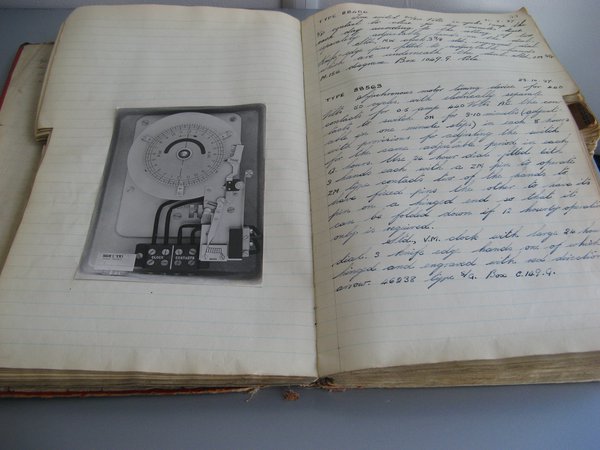
The sundial column at Seven Dials
This post was written by Peter de Clercq
As I live in central London, I often pass through Seven Dials, an area between the districts of Covent Garden and Soho where seven streets meet at a roundabout. In its centre stands a pillar or column with six vertical sundials at its top.

The area resulted from a building scheme of the politician-entrepeneur Thomas Neale MP (1641–1699), whose name lives on in nearby Neal’s Street and Neal’s Yard. He commissioned the architect and stonemason Edward Pierce to design and construct a sundial pillar in 1693-94 as the centrepiece of his development. Pierce’s drawing is in the British Museum and shows six sundial faces.
Why six, not seven? We are told that the column itself was the seventh, so it would act as style or gnomon, casting its shadow on the ground. If so, there must have been a noon mark somewhere. One thing is certain: the column never ‘supported a clock with six dials’, as the London Encyclopaedia tells us.
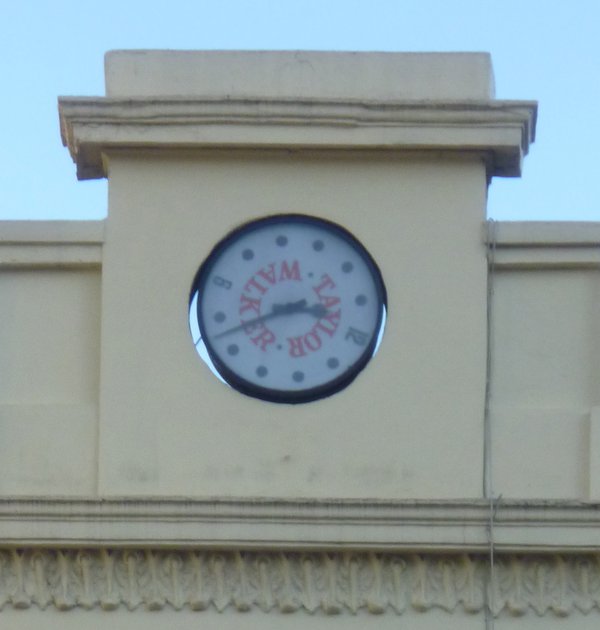

The column that we now see is not Edward Pierce’s original. That was removed in 1773 (in my next blog I will discuss what happened), and for two centuries there was nothing on the roundabout.
In 1984 a charity was set up (the Seven Dials Monument Charity, now Seven Dials Trust), who managed to raise funds to restore what it called 'one of London’s great public ornaments'.
Five years later the new column was unveiled, complete with six new sundial faces in a striking blue colour. There is much explanatory information on and around the pillar. Do have a look when you are next in London’s West End.
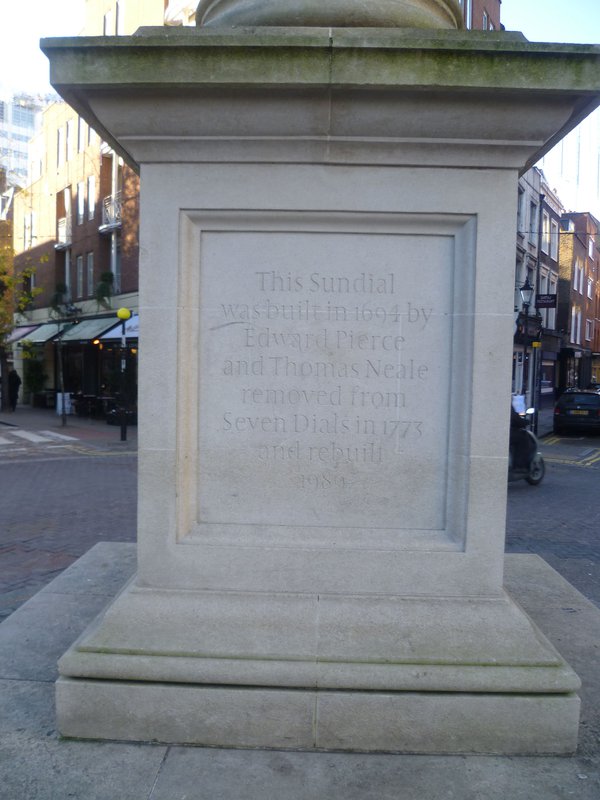


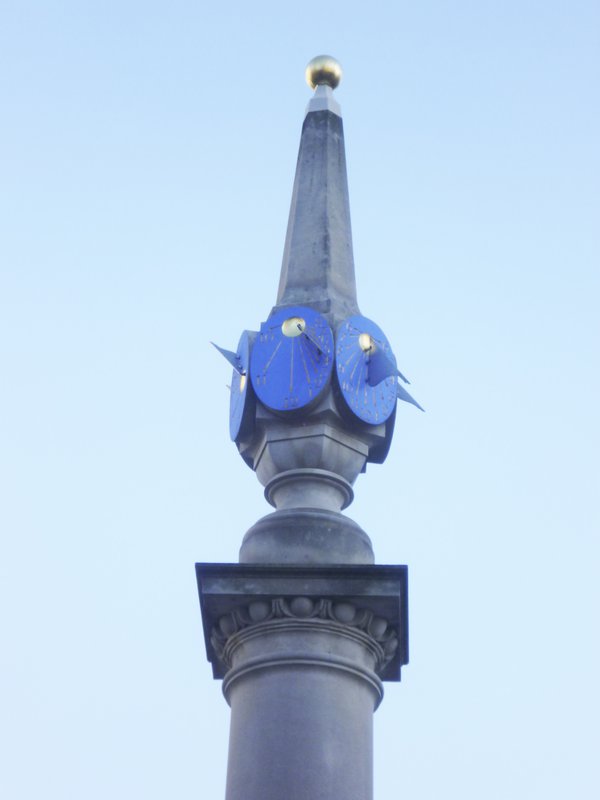
All the nation’s oil paintings online
This post was written by David Rooney
Richard Dunn’s blog post about the Board of Longitude online project reminded me of another exciting digitisation. The ‘Your Paintings' website, run by the BBC in partnership with the Public Catalogue Foundation, aims to show every oil painting held in a UK national collection.
This is a remarkable project. You can see 212,861 paintings online!
I work at the Science Museum, and 297 of our paintings are represented on the site. I picked out three to show you, by Edward Frederick Skinner, depicting file-making and spring-making during the First World War.

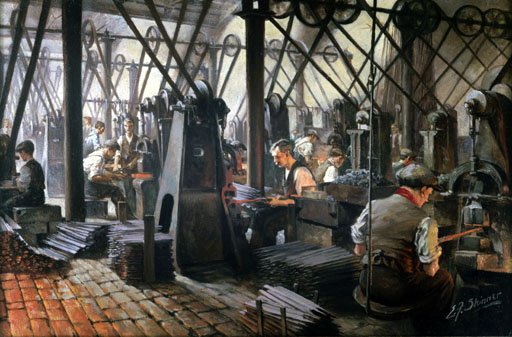

OK, they’re not strictly horological, but I think they’re wonderful, and offer a welcome view of women in the engineering workplace too.
This is also an interactive project. You can get involved by tagging the paintings – choosing your own words to describe what can be seen in the images. This will grow to become an important user-generated finding aid.
And so to horology. There are 59 paintings which include the word ‘clock’ in the title. 157 include the word ‘watch’ (though that one’s clearly not such a good search term). ‘Horology’? None, yet, but for ‘antiquarian’ there are three. And there’s one with the word ‘horological’ (the British Horological Institute’s collection is represented).
But that’s titles. Like I said, you can tag paintings yourselves, so if you find a painting which depicts a watch, or a clock, or a fusee-cutting engine or whatever, then tag it – whatever its title – and help others find it in future.
My fellow blog-writers from the British Museum and the National Maritime Museum will doubtless chip in to mention highlights from their own collections. But, really, it’s hard to know where to start! Happy viewing…
Stand up for watches
This post was written by David Thompson
Today we all take the ownership of a plain ordinary watch for granted and such watches are easily purchased at easily affordable prices. The same is true of the cheap and simple clock, be it a wall clock for the kitchen or a carriage clock for the shelf or mantel.
From the latter part of the 17th century until the end of the 19th century it has been possible to purchase a stand which enabled the owner to transform the watch into either a wall clock or a shelf clock simply by placing the watch in a specially made case.
Examples vary in shape and size, but two relatively rare ones are shown here. The first is a splendid tortoise-shell and ebony-veneered stand which can either be wall mounted or table standing. It is designed with an opening front to enable a common pocket watch to be placed inside to perform as a clock. It was made in England in about 1690-1700, and is enhanced by a portrait bust of King William III surmounted by a crown on the front brass decorative panel.
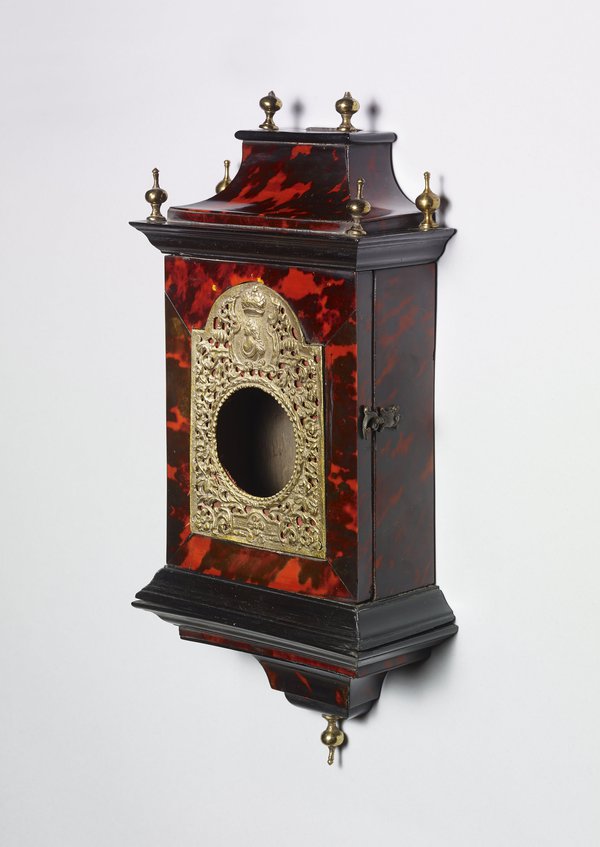


From a similar period is a French example which has a characteristic so-called ‘boulle’ case.
The technique of inlaying brass into tortoise-shell was pioneered in Paris by Charles André Boulle 1642–1732 and in consequence this type of work is named after him, although there were many workshops in Paris using this amazing technique. The material actually used was not tortoise but commonly hawksbill turtle. In some instances the craftsman would make use of the negative and here the pattern on the back is the negative left from producing the brass inlays for the front.
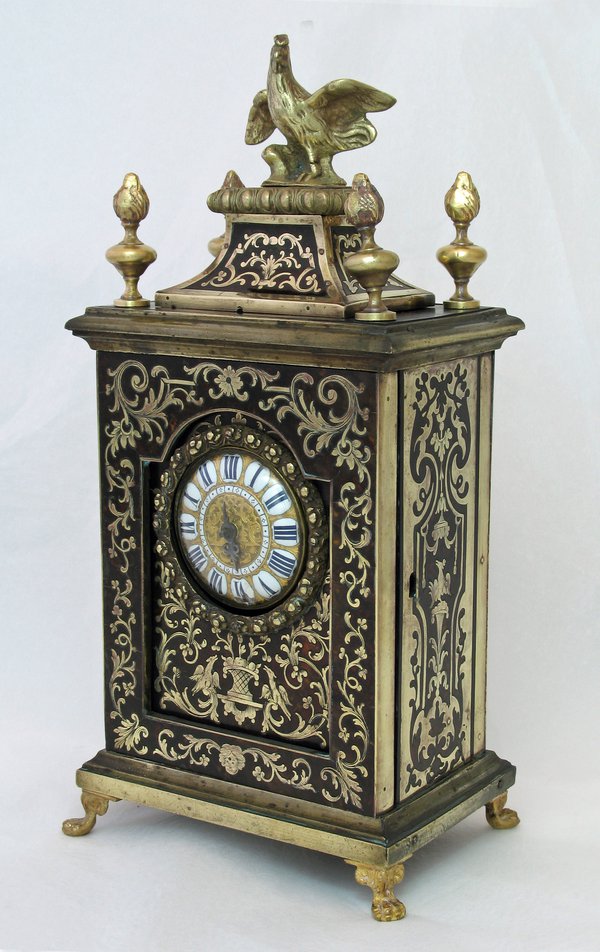

In contrast to these two elaborate and relatively expensive watch stands, lastly is a 19th century stand consisting of a simple folding wooden box which would allow an ordinary watch to be placed on a bedside table for night use.
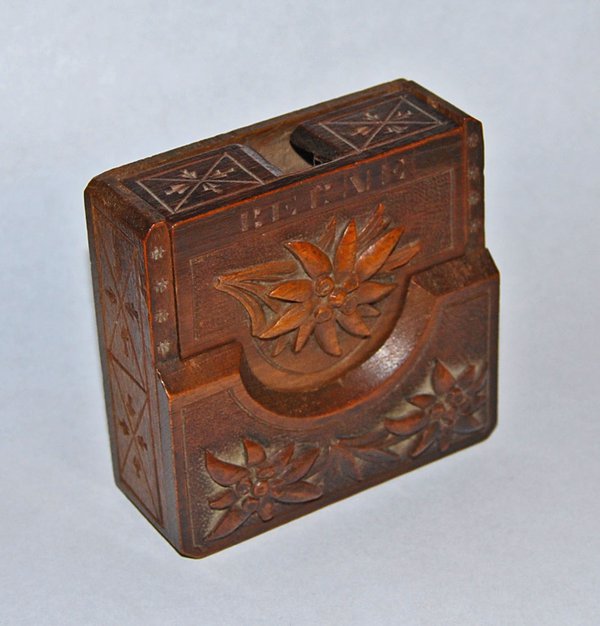
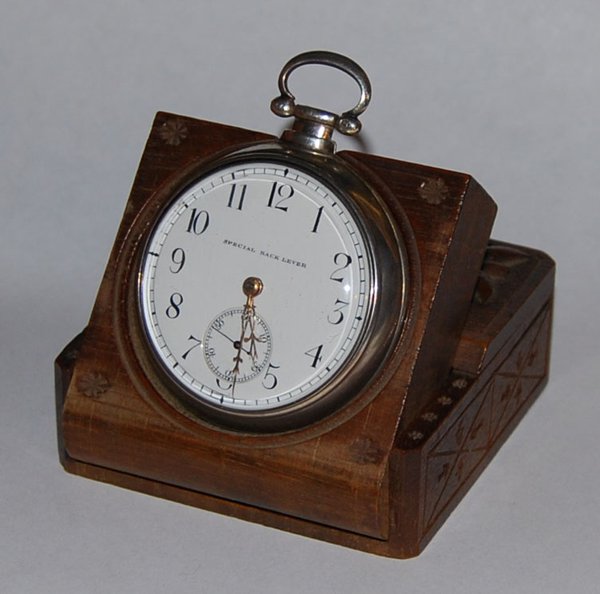
John Harrison and the Board of Longitude go digital
This post was written by Richard Dunn
Last week, the Cambridge Digital Library launched some samples of material from the Board of Longitude archive that will interest anyone wanting to know more about John Harrison, the Board of Longitude and the development of timekeeping at sea (among many other things).
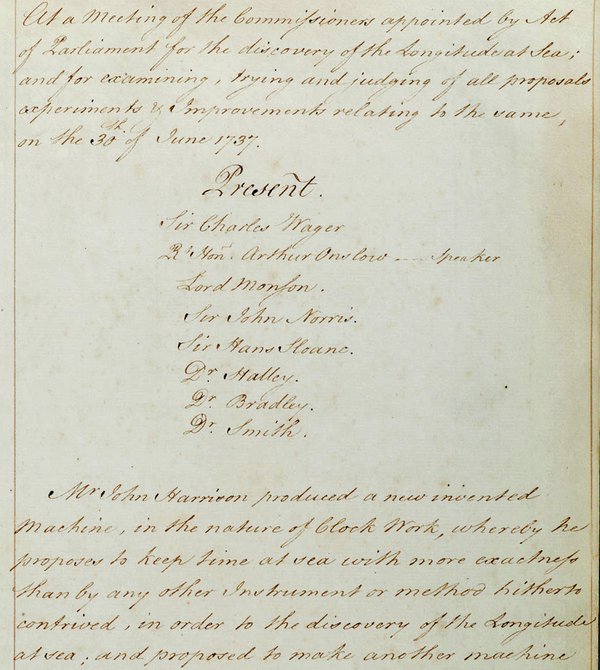
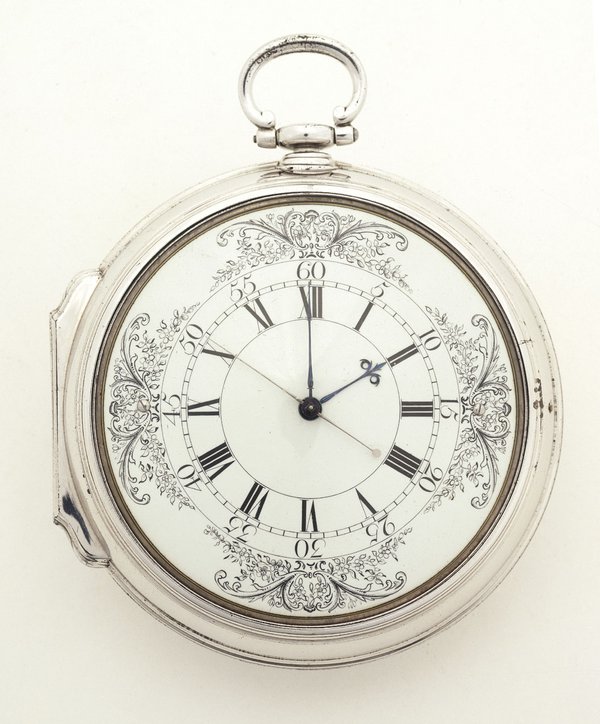
Three volumes from the Board’s archive have just been put up: the first volume of confirmed minutes (1737-1779), which includes a full transcription and covers all the meetings involving John Harrison; William Wales’s log from James Cook’s second voyage (1772-75), on which Larcum Kendall’s first marine timekeeper (K1) was tested alongside three by John Arnold; and a group of letters and reports by astronomers and captains from late-18th and early 19th century voyages of discovery.
For all three volumes, there are also links with the collections at Royal Museums Greenwich.

The trial launch is part of a JISC-supported project, ‘Navigating Eighteenth Century Science and Technology: the Board of Longitude’. This is a collaboration between Royal Museums Greenwich and the University of Cambridge that is going to digitise all the surviving archives of the Board of Longitude and related material in Greenwich and Cambridge. The remaining material will go online during the summer of 2013.
The project team would like to get feedback on how the current version works and things they can do to improve it. There should be lots of interesting stuff in the three volumes now online, so please have a look and leave any comments via the feedback function on the Cambridge Digital Library.
What on earth?
This post was written by James Nye
In a few days, Francoise Collanges will embark on a project involving the Alexander Bain clock at The Clockworks. We will survey the clock, compare it with examples at the Science Museum, the Guildhall and Greenwich, and work out how to operate it safely over the long-term.
Someone asked if we intend to drive it with an earth battery (the way Bain did), and this reminded me of an experiment, back in the 1990s.


What’s an earth battery, you may ask? Remember the ‘potato clock’, where the power for a small battery clock comes instead from a galvanised nail and copper wire inserted into a potato? The potato provides the ‘electrolyte’ between the two metals – it’s the water in the potato really – allowing electrons to pass from the zinc to the copper, providing Volts.
In an earth battery, the moist soil beneath the surface allows the same thing. The battery is ‘used up’ as the zinc disappears.
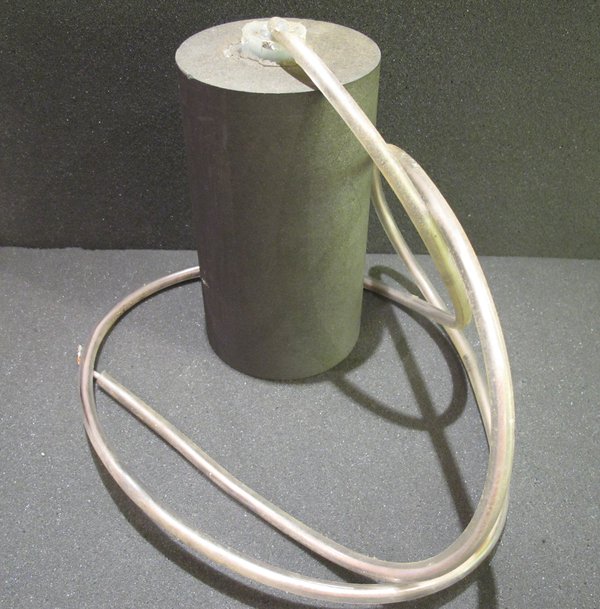
Elements can be ranked ‘galvanically’ – indicating the volts you can achieve from a combination. Magnesium/copper gives 1.45V, zinc/copper (potato clock) 0.9V. But Bain buried zinc plates and a lump of retort coke (carbon), producing 1.1V, enough for his sensitive clock.

In Leicester, an earth battery apparently powered a clock for about fifty years, and we set out to beat this run – calculating the zinc needed, given the rate at which it would be consumed – 2,671 grams in our case. Two specialist firms produced the carbon and zinc electrodes to our design.

I buried them a metre down and ran a clock for several months. But the battery stopped working. A post mortem suggests a flaw in our zinc block – it should probably have been a large thin plate – with maximum surface area. The thousands of surface flaws in Bain’s retort coke were actually an advantage. We could give it another go at The Clockworks – trouble is, we sit on concrete, so we’ll need to ask the neighbours if we can bury electrodes in their garden!
Sundials can be sobering and noisy
This post was written by Peter de Clercq
Whereas a clock or a watch tells us at a glance what time it is, finding the time with a sundial is less easy. And it only works when the sun shines. Serious limitations, one might argue.
But this does not make them less attractive or fascinating. Indeed, there are societies entirely devoted to the subject, such as the British Sundial Society (BSS) whose members study and record old sundials and enjoy designing and discussing new ones.
Sundials come in many sorts. Like clocks and watches, they range from pocket-sized (Figure 1) to monumental (Figure 2), and from straightforward to mind-bendingly complicated.
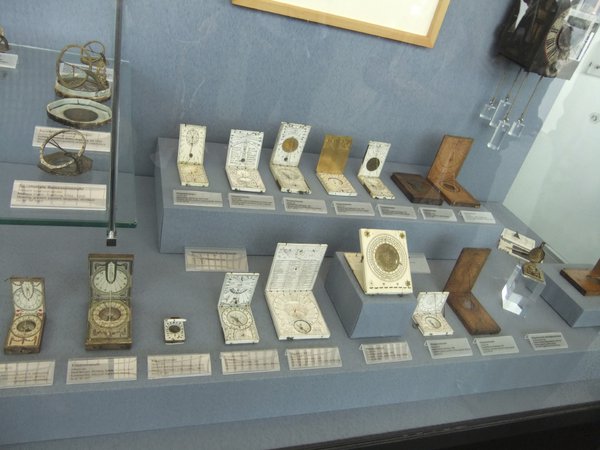

What I like about them is that they can come with arresting imagery and texts. An example is the sobering memento mori we saw years ago on an Austrian church (Fig 3). The Grim Reaper would fit perfectly in the exhibition Death: A Self-Portrait, currently at the Wellcome Gallery in London.
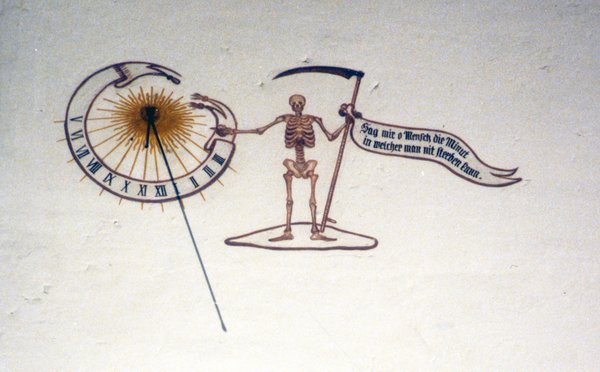
Sundials are quiet. Not for them the reassuring tick-tack of a clock, or the quarterly or hourly chimes.
But there is one exception: the cannon dial, also known as solar cannon or noon cannon (Fig 4). It is fitted with a burning lens, so arranged that the Sun’s rays are directed to the touch hole of a small cannon. At noon precisely, it goes off with a bang! People could set their watches by it (Figs 5 and 6).
It was an acoustic variant of the Greenwich time ball, which for generations has been dropped every day at 1 pm sharp – initially for ships’ navigators to check their chronometers, and now purely as an enjoyable public spectacle.
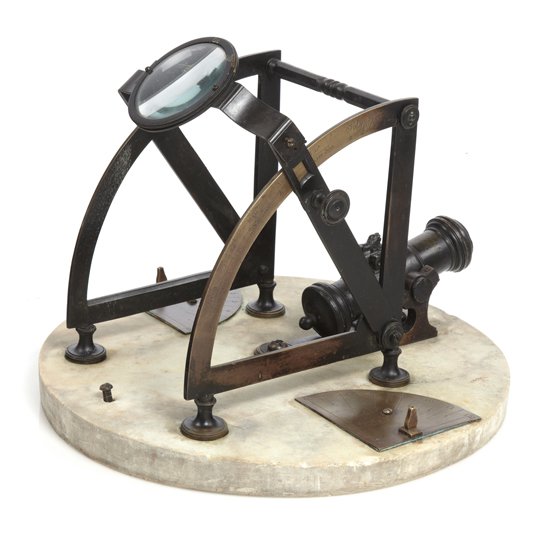
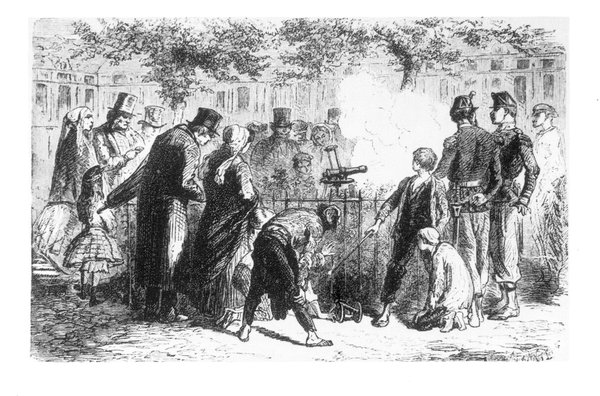

Seventy-Seven Clocks
This post was written by David Rooney
One of the security officers where I work stopped me a few weeks ago. He was reading a crime fiction novel and thought I might be interested. It’s called ‘Seventy-Seven Clocks’. You can perhaps see why he thought of me.
During these long January evenings, many of us find time to catch up on our reading – and there’s a lot to catch up on.
I am sure you are already onto your second reading of Bob Miles’s superb masterwork on the Synchronome company, published by the AHS last year. And if you haven’t yet seen a copy of Ian White’s exploration of English clocks for the Eastern markets, the AHS’s latest book, then there’s a treat in store for you.
But having devoured those two books, you might want something a little lighter, and for that, I can recommend Christopher Fowler’s Seventy-Seven Clocks.

With chapter titles such as ‘Horology’, ‘Clockwork’, ‘Automaton’ and ‘Mechanism’, it’s shot through with mechanical ingenuity. (There’s also ‘Vandalism’, ‘Detonation’, ‘Darkness Descending’ and ‘Glorious Sacrifice’, so it’s not for the faint-hearted.)
I don’t want to spoil the plot, but suffice to say anyone who’s a member of the Worshipful Company of Clockmakers, or who collects clocks and watches, or who has ever been involved in running a business might well be absorbed by Fowler’s fictional tale.
It’s beautifully detailed, acutely observed, and full of horology – although I never imagined it could be so wicked ! I’ve since read other titles in Fowler’s series and they’re great. One mentioned the sundial-fountain in St Pancras Gardens by horological philanthropist Baroness Burdett-Coutts that I wrote about a few months ago. Coincidence!
Happy reading, whatever’s on your bedside table, and very best wishes to you all for 2013.
Time to pay
This post was written by David Thompson
With all the current talk about taxation, I am reminded of a futile attempt to raise money introduced by William Pitt in 1797. Now commonly referred to as the Clock Tax it involved the levy of charges for clocks and watches under an act which was put into effect on the 5th July 1797.
Under the act, levies would be charged at the rate of 5 shillings for every clock and 10 shillings for every gold cased watch or a watch with a case enamelled on gold. Silver and base-metal cased watches would incur a charge of one shilling and six pence. Householders, tenants and businesses alike were to provide a signed declaration of all the clocks and watches in their possession for the purposes of assessing the amount to be paid. Inspections would be made and the taxes levied according to the number of items.
Of course, people hid their clocks and watches and made false depositions to such an extent that the whole idea became unworkable and was quickly abandoned.

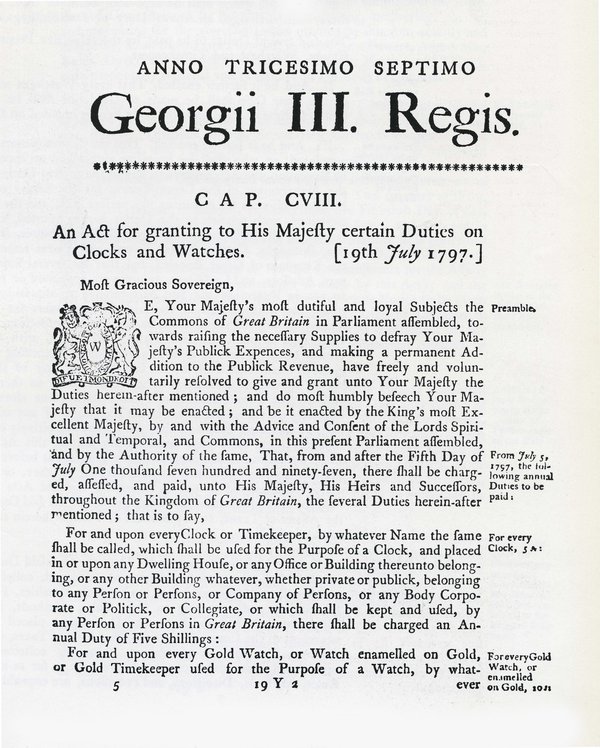
At the time of the tax a rather splendid satirical print was made suggesting that as the tax was something of an absurdity, perhaps the government were considering levying a tax on the embroidered decorations on stockings which are called ‘clocks’. The coloured print was made by A.C. Ansell in the style of the well known caricaturist George ‘Moutarde’ Woodward and published by S.W. Fores of 50 Piccadilly, London, on 9th August 1797.
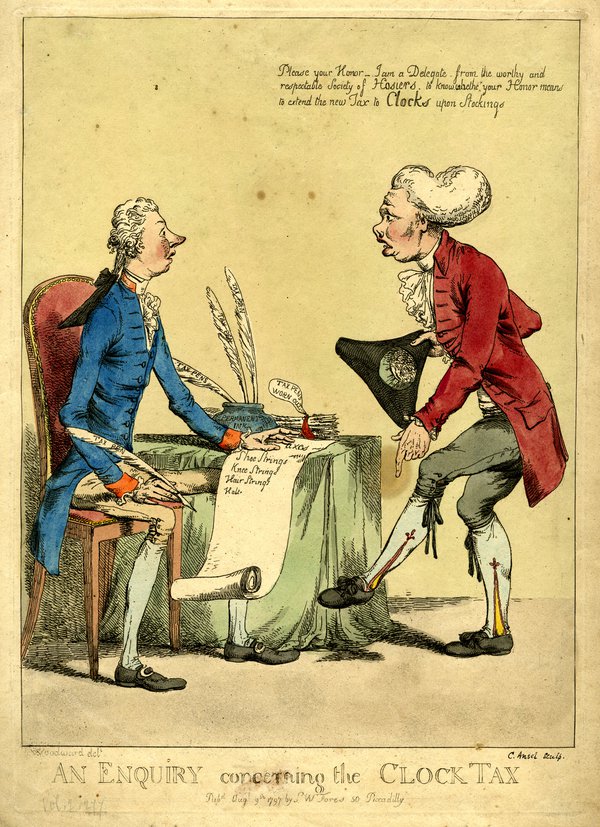
With the increasing use of mobile phones as time-tellers, perhaps the answer today is a tax on these ubiquitous items!
(Thanks to Marjorie Hutchinson for timely advice)
Clocks in Berlin museums
This post was written by Peter de Clercq
Every year the AHS organizes a Study Tour for members to see collections of clocks and watches abroad.
The 2010 tour went to Germany and included two days in Berlin. As reported in Antiquarian Horology March 2011, they saw many fine clocks in the Charlottenburg Palace, as well as in the New Palace of Sanssouci in nearby Potsdam.
Last month I was in the German capital myself, and had a chance to visit some of the many other museums, and spotted further items of horological interest. The German Technical Museum has an impressive railway collection in two former loc sheds. In the entrance building they display the clock of the railway station of Breslau (now Wroclaw), dated c. 1850, complete with its vertical lead-off work and the dial. Next to it is an earlier turret clock, with stones as weights for the going and striking train, as well as – perhaps more unusually – for the pendulum bob.

Opposite Charlottenburg Palace is the Bröhan-museum, specialised in Art Nouveau, Art Déco and the Berlin Secession. Among the treasures of applied arts in ceramics, glass, wood and metalwork were two mantel clocks in Art Nouveau (also called Jugendstil) style, and a clock with ‘TEMPUS FUGIT’ (Time Flies) on the dial instead of numerals.
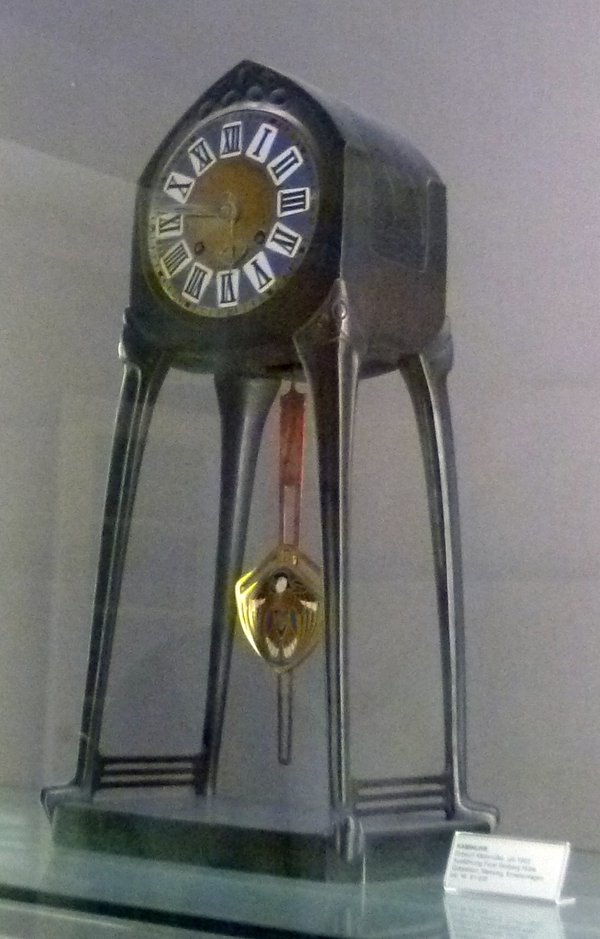
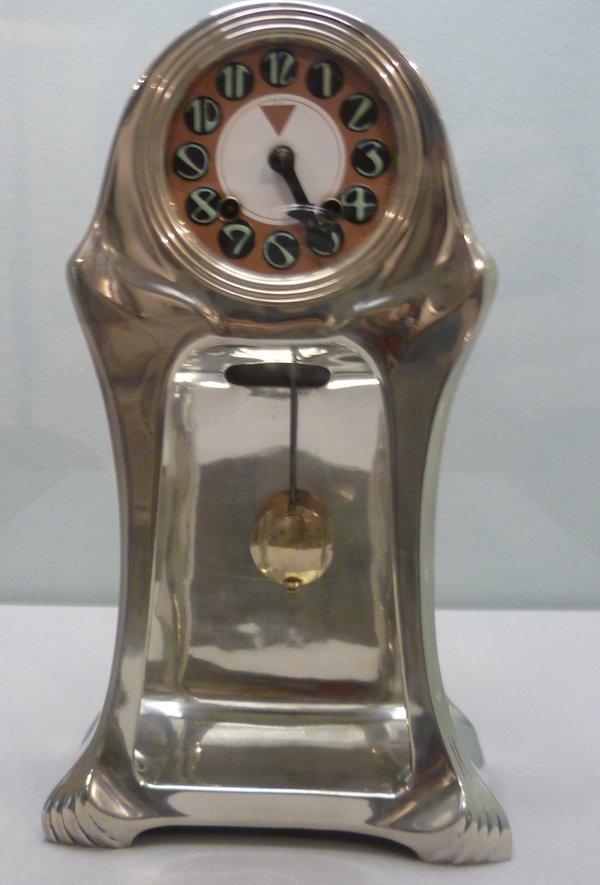
Any music lover will enjoy the Museum of Musical Instruments, located behind the famous Philharmonie concert hall and built by the same architect, Hans Scharoun.
Among the hundreds of historic instruments are two more than man-sized musical clocks. Both are among the dozens of instruments that can be heard on the audioguides supplied at the entrance. What a treat to hear these gentle sounds in the knowledge that traffic noise is just on the other side of the wall.
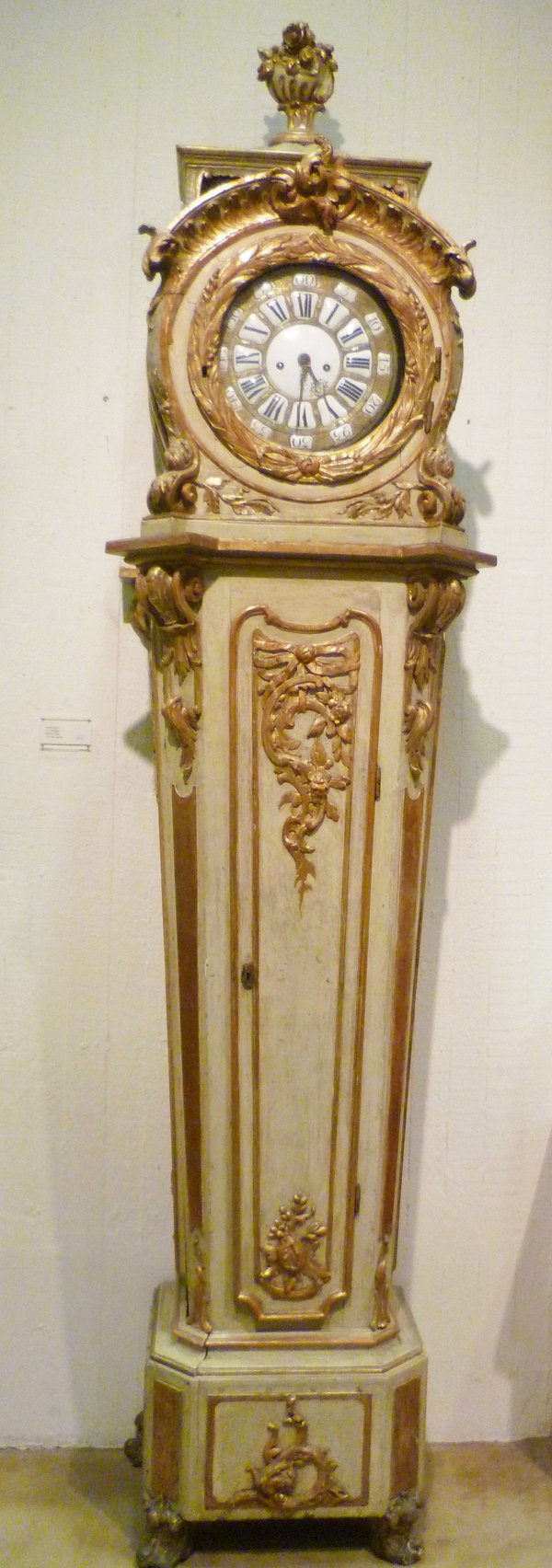
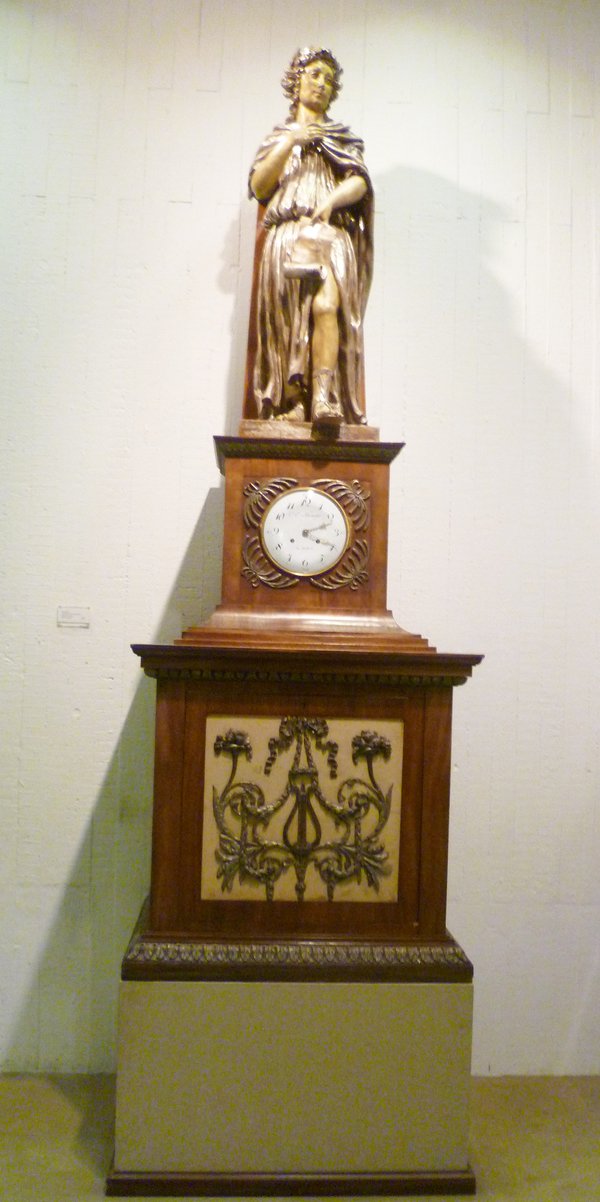
Job done!
This post was written by Matthew Read
Public clocks that don’t work; there are thousands of them. An irritation, sign of the neglectful and difficult times or simply a reflection of the lack of need for the dissemination of time in that format? Big questions but in this case a relatively simple solution with interesting conservation issues thrown in.
The plan to reinstate the long-dilapidated village hall clock with a modern equivalent. Easy reliable low maintenance solution? But what actually happened to the earlier clock? Did it still exist? Could it be reinstated? Questions sometimes make things more complicated but in this instance, the result was felt to justify the extra energy.
The re-discovered clock was probably originally installed in the 1930’s; Smith mains synchronous movement with hand setting by leaning out of the window to reach the adjusting knob. Although potentially perfectly serviceable, due to the mains voltage and window leaning out of combination , it was decided to replace the movement with a low-voltage slave, controlled from inside the building (the original movement packaged within the clock case.
The painted aluminium dial had discoloured with parked hands and some corrosion. Repainting the dial would have obliterated the original/existing surface so a decision made to copy the dial on the reverse, thus preserving what existed and the dial was turned inside-out.
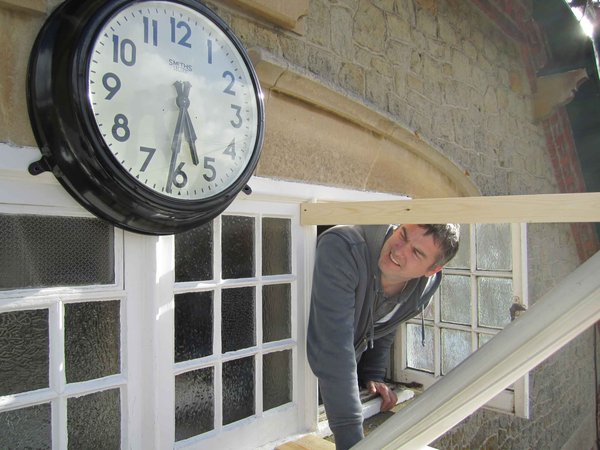

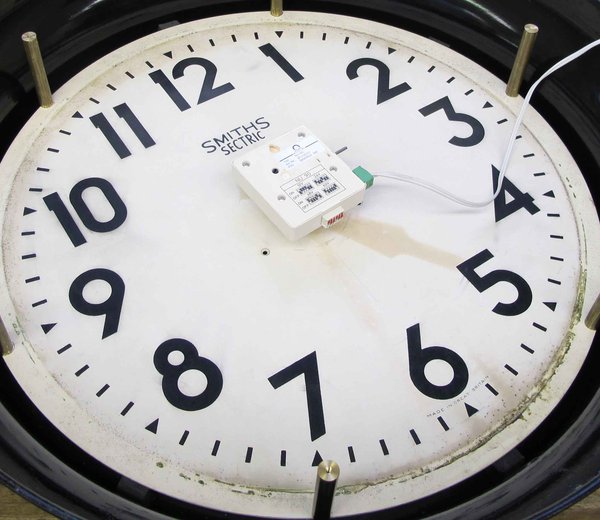
Happy villagers, public time restored, happy conservation compromise, job done.
The Empire Hall was built in 1907 for the village by James Buchanan (later Lord Woolavington) of Lavington Park.
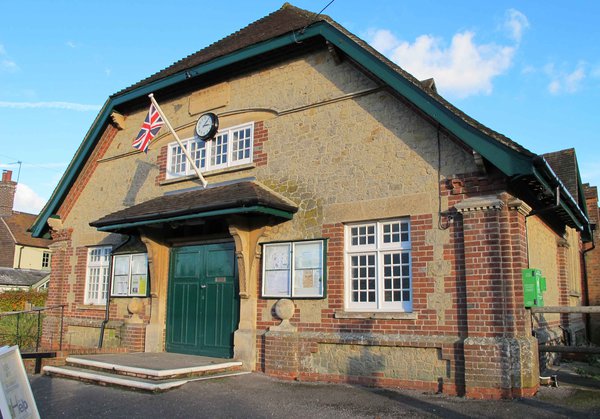
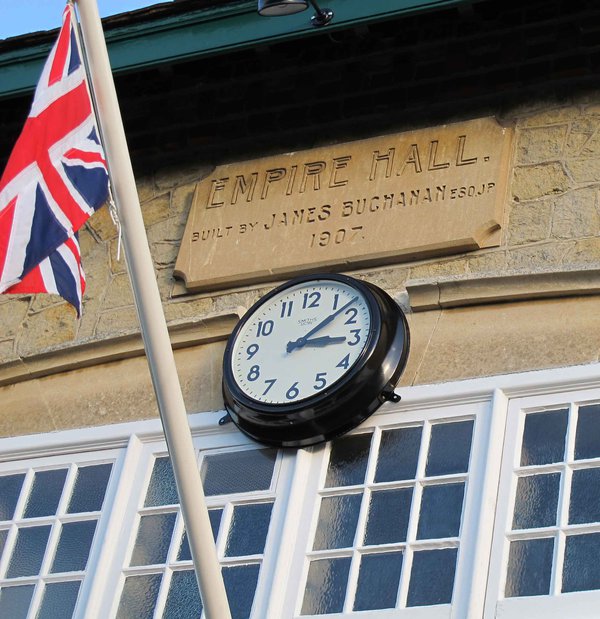
Time on the BBC
This post was written by David Rooney
A couple of weeks ago, BBC radio listeners around the world celebrated the 90th anniversary of the corporation’s founding as the British Broadcasting Company.
On 14 November, a special edition of Simon Mayo’s Drive Time show was broadcast live from the Science Museum, London, in front of the first BBC transmitter, known as ‘2LO’. It’s on show as part of a free temporary exhibit.
Radio broadcasting changed the face of timekeeping. When the BBC was founded in 1922, wireless time signals had been around for about a decade, transmitted from the Eiffel Tower, but they were for specialists, not the public. The BBC brought accurate Greenwich time into the living rooms of the nation.
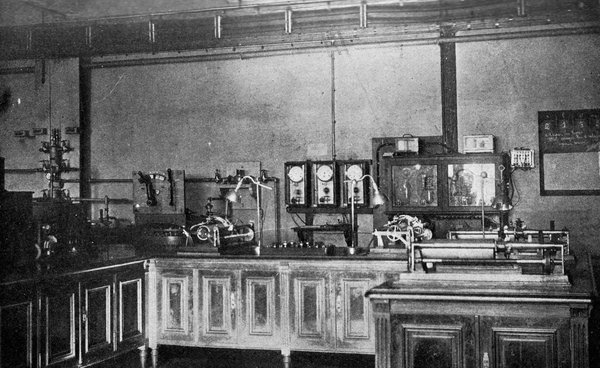
The first BBC time signals came from the announcers reading out the time. Within a year, a special set of tubular bells was in use, sounding time by the Westminster chimes. But in 1924, the now-familiar ‘six pip’ time signal began. And it’s still in use today – although listeners on digital radio hear the signal a couple of seconds late. Progress, I guess.

But the six pips wasn’t the only time signal set up by the BBC in its earliest years. The familiar sound of Big Ben was also captured live by BBC microphones from 1923 – and that system too is still in place.

It’s time, I’m afraid, for the inevitable plug: to find out more about time signals on the BBC, try my book, Ruth Belville: The Greenwich Time Lady. In it, you can discover why Dame Nellie Melba had reason to say, ‘young man, if you think I am going to climb up there, you are greatly mistaken!’
Happy birthday, BBC…
A pointless exercise
This post was written by David Thompson
Sometimes, ideas were way ahead of their time and when they were first thought up they had no application. Subsequently, however, the concept became a popular and widely used one.

Today with frequent and easy air travel, as well as instant communication around the world, the appearance of a world time dial on a watch makes perfect sense and indeed such dials are common. A simple Google search for ‘World Time Watch’ brings up over 2 million references.
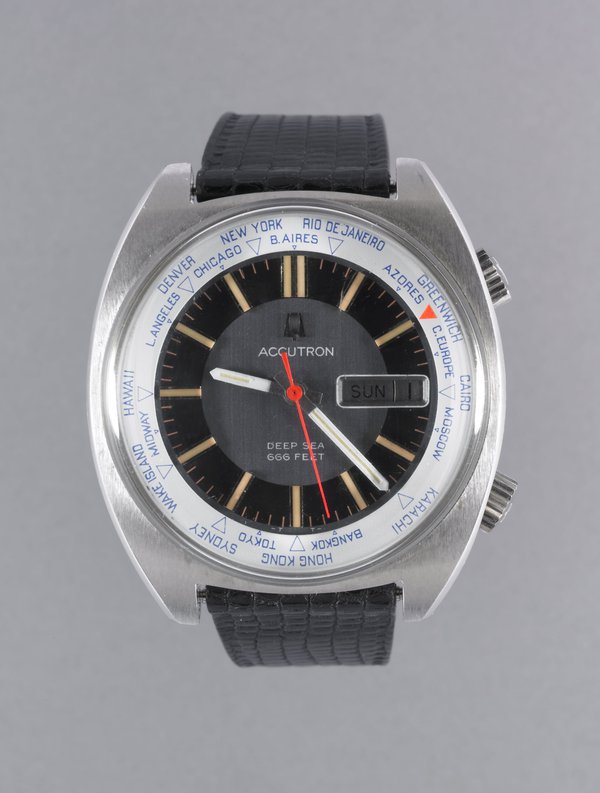
What use would such a watch be in the second half of the 18th century.
Imagine a man-about-town in London showing off his latest purchase to his friends and being proud of the fact that he could tell them what time it was on other parts of the globe. When any communication with such places would have taken months at least, you can just hear his friends saying,‘fascinating, but what’s the point – and where is Antiqua anyway?
Nevertheless such watches did exist in the mid-18th century and one example survives to this day in the British Museum Collections.
It is a gold pair-cased watch made by John Neale in London in 1770. It shows the time in London, Mexico, Persia, Antegoa, Russia, Italy, China and other exotic places. It was probably sold as a gimmick, as something out of the ordinary and a curiosity which didn’t need to have a purpose – just a bit of fun for the owner who could say ‘did you know………….?


A eureka moment of recognition
This post was written by James Nye
Sometimes, every once in a while, one’s record-keeping comes up trumps. Rooney and I wrote up the history of the Standard Time Company in Antiquarian Horology back in 2007, and widened our scope in the BJHS.
Since then, very little further factual detail has come to light. Certainly there has been a dearth of newly found objects badged STC – which is a shame. We had hoped our piece would bring to light more clocks and ephemera.
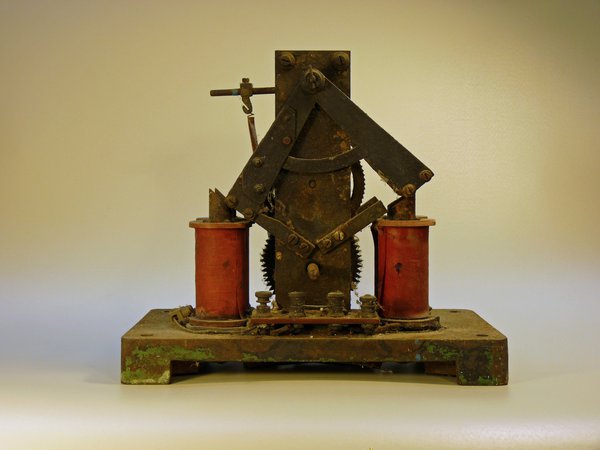
Keith Scobie-Youngs of the Cumbria Clock Company unearthed an unusual tower slave last year, which a couple of us thought might well be from STC, but we lacked any evidence. It is of very distinctive form and bears no signature, or if there is one it is beneath layers of typical clock-tower grime. Despite no obvious identifying marks on the corpse, there was nevertheless buried deep in my memory a faint recollection of something of this form.
I didn’t spring naked from my bath and run around West Norwood, I admit, but I did just have that ‘Eureka’ moment, when I remembered having scanned a document that George Arthur, the authority on all matters related to Lowne clocks and instruments, had shown me, years ago.
In the 1920s, there was a period when Joseph William Molden, an Australian entrepreneur, had built a small electric clock empire, which brought together STC and Lowne for a time.

In the Lowne archive there is a picture, very faded, of precisely the device in question, mocked up with leading off work, sitting atop a leather stool. A typewritten description attached to the picture led me to the Horological Journal of 1920, and there, bold as brass, was our movement, titled ‘New Patent Electric Impulse Movement’.
Click here to see the patent. In conclusion, a neat tie-up between original documents and a recovered object. Too bad we still cannot locate one of the master clocks used to drive it, but we live in hope.
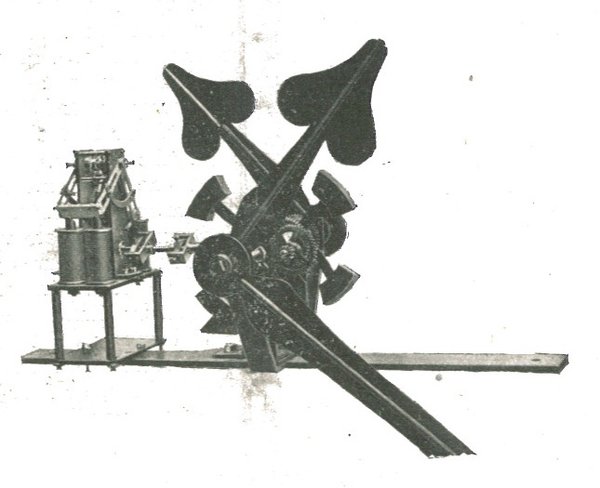
Anyone for Venice?
This post was written by James Nye
Rome may be the ‘eternal city’ but for La Serenissima – Venice – time also stands still, or at least it has for me over four decades of visiting the city, with various familiar walks reviving favourite memories at each corner turned.
Something I have noticed for the last thirty years or so is a series of public clocks in the campos and calles – not galley slaves, but alley slaves. These are minute-impulse devices, mostly with a single dial, but a few double-dialled versions on street corners. They have a fairly classic or traditional feel to them, with opalescent dials that are back-lit at night, and cast cherubic and heraldic detailing to the metal cases.
I have never succeeded in tracking down anyone I could ask about their origins or date – if anyone can help, please do let me know. There might be twenty or thirty dotted across the city, and while some are in obvious positions, a few present themselves in seemingly quiet and untravelled quarters, perhaps reflecting changing patterns of street usage.
The cases, dials and hands are survivors of an original installation – on asking among expert friends one commented the pattern is one that could have been used by any one of many different electric clock firms – we would only know which if we could see inside, and I didn’t have a ladder on me this time. No doubt the original central master-clock and city-wide wiring has all long disappeared.
On a visual inspection I would judge each clock now to be independently driven by a local, radio-controlled, electronic master clock, thus giving precise time, corrected automatically for daylight saving. The Venetian authorities have therefore understood (unusually among their peers) that the impulse-clocks themselves can easily be made to last for generations – it is the network that supplies the impulses which may need updating – a message I bang on about frequently, as friends will know.
Venice – a timeless city – moving with the times.
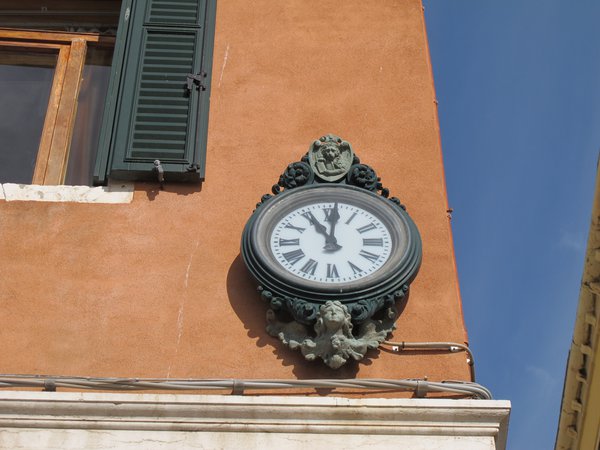
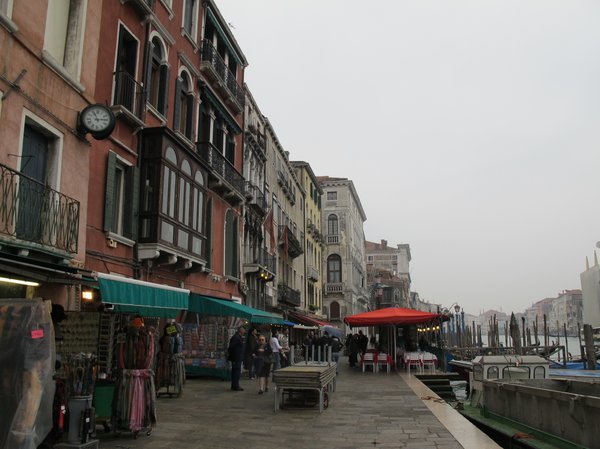
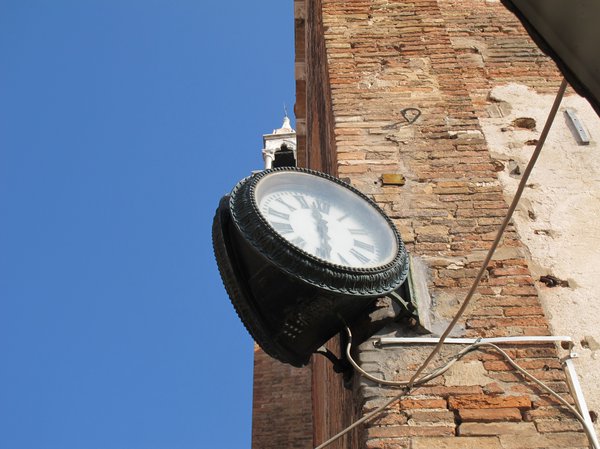




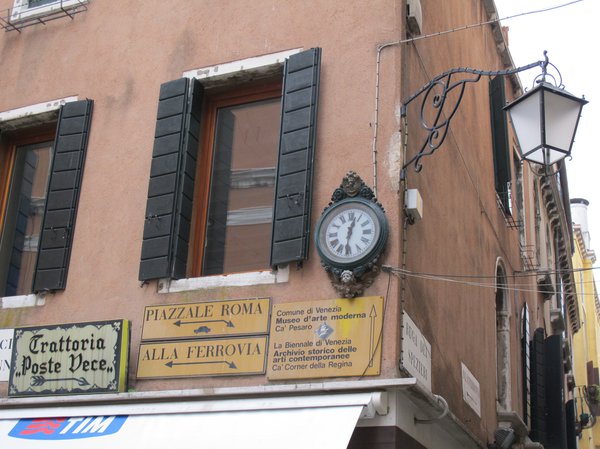
Letters on the dial
This post was written by Peter de Clercq
We are so used to telling the time from dials that we don’t really need the hour numerals. Some dial designs omit them altogether – distinctly uncluttered but also perhaps a bit dull. There is an alternative, which I find more fun.
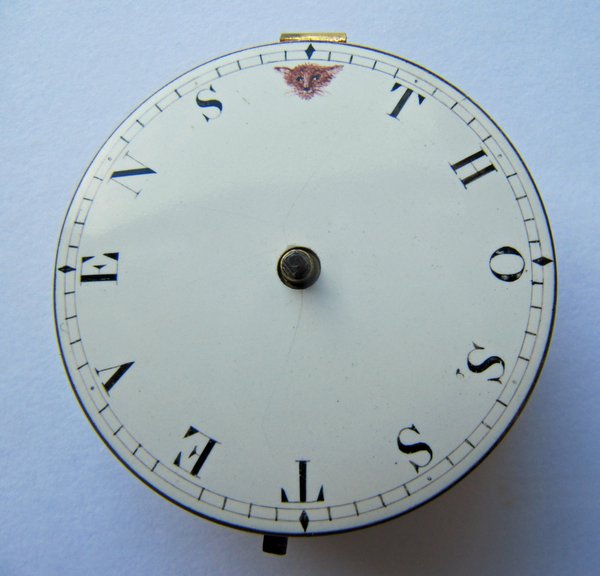
Watches can be personalized by substituting the letters of the owner’s name for the hour numerals. As Cedric Jagger writes in his book The Artistry of the English Watch , this was by no means uncommon.
If the name did not have exactly twelve letters, the designer had to be inventive, as the three watch photos here demonstrate. The one with JAMES CATLING, dated 1814, gave no problems, but for GEORGE CATLING, dated 1815, NG had to be linked. On the other hand, for the eleven-lettered THO[MA]S STEVENS, dated c. 1840, the designer used a fox’s head at 12 o’clock.
Was this randomly chosen or was the owner perhaps an avid fox hunter?

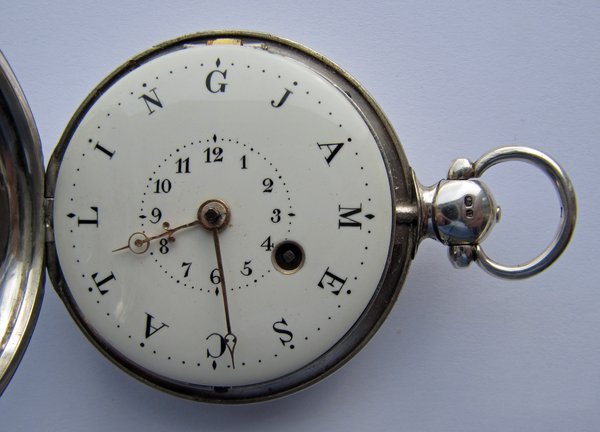
At least two English churches sport a lettered dial. The one on St Peter’s Church Buckland in the Moor, Dartmoor reads ‘My Dear Mother’, and was commissioned by the man who donated the clock along with three new bells in 1931. And during a recent trip in Norfolk, the AHS Turret Clock Group saw ‘Watch and Pray’ on the dial of the clock at All Saints Church in West Acre.
These are the first words from Matthew 26:41, where Jesus is addressing his disciples on the Mount of Olives just before his crucifixion: ‘Watch and pray, that ye enter not into temptation: the spirit indeed is willing, but the flesh is weak’.
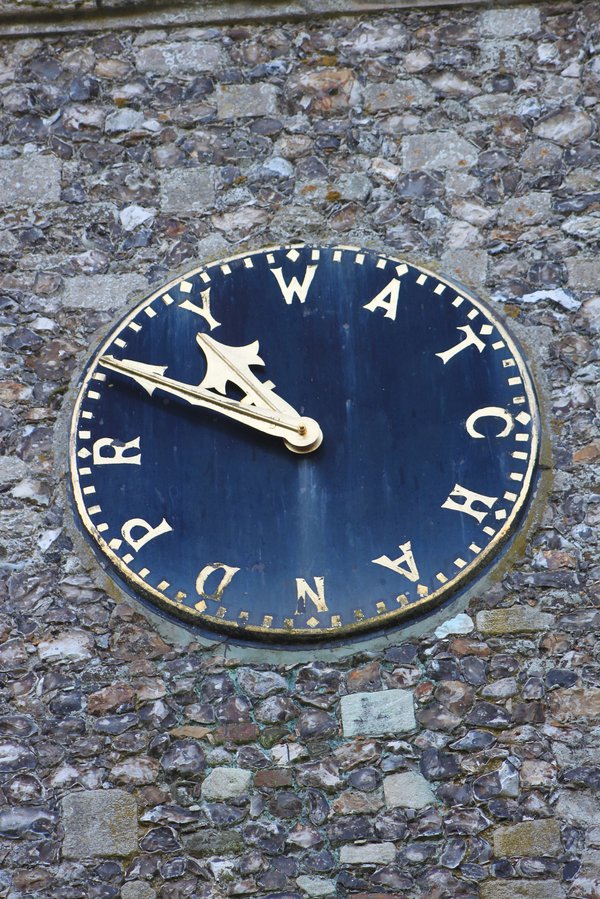
Finally, I was interested recently to come across this image of a mid-20th century electrical wall clock with special dial lettering and hands for the York Evening Press newspaper office, supplied by Telephone Rentals.

If you like this kind of thing, you may want to join a group of enthusiasts who share images and information online on just that: clocks and watches with letters. But on their database I do not see any longcase clocks with letters instead of numerals on the dial. So if you know of one, please leave a comment!
For use of their photos I thank three AHS members: Dave Stables (who published on the Catling watches in Antiquarian Horology of June 2011 and also online), turret clock specialist Chris McKay and the chairman of the AHS Electrical Horology Group, Martin Ridout.
Time by telephone kiosk
This post was written by David Rooney
A few weeks ago I wrote about telephone kiosks. Today I’m returning to that theme, because I’m fascinated by how many clocks are embedded in our daily lives, hidden in the everyday infrastructure surrounding us.

The nights are drawing in. We’ve reset the clocks back to GMT for another year, and many of us start travelling to and from work in the dark. Thanks goodness for street lights – and for the time switches that turn them on and off every day. Countless clocks hidden inside countless lampposts.
But, every so often, hidden technologies reveal themselves, either by accident or design. In 1931, Britain’s watch and clock makers were told about a new way to find the time when out on the street.
'The latest type of Venner Time Switches installed in the G.P.O. telephone kiosks have a glass window over the dial. The purpose is to enable their timekeeping to be more easily checked, but in addition, the device will be useful to the public, for the time to the nearest five minutes can easily be seen.' The Watch and Clock Maker, 15 November 1931.
These time switches were used to operate the kiosk’s lamp, and they were pretty sophisticated.
Each one was a spring-driven mechanical clock, wound up every eight hours by an electric motor. In case the kiosk’s power supply failed, the time switch had enough power in its spring to operate the clock for three days. And every day the switching times were adjusted to track the rising and setting of the sun.
You can find out more from a 1934 article reproduced here. But could the time switches really be ‘easily’ seen, as the quotation states? Here’s a photograph of one of them in situ. I’ll leave you to decide…
Where on earth have you been?
This post was written by David Thompson
Sometimes watches have a particular association with a particular person and we know about from an inscription written somewhere on it.
This particular watch, by Samuel Toulmin of the Strand in London, made in 1775, has a finely engraved inscription on the back of the outer case, ‘Thos Justice Esq. Appleford Berks’. There was a Thomas Justice of Appleford who is described as having died of ‘intemperance’ in September 1789. Could he have been the first owner of the watch who had it inscribed on the back in 1775?
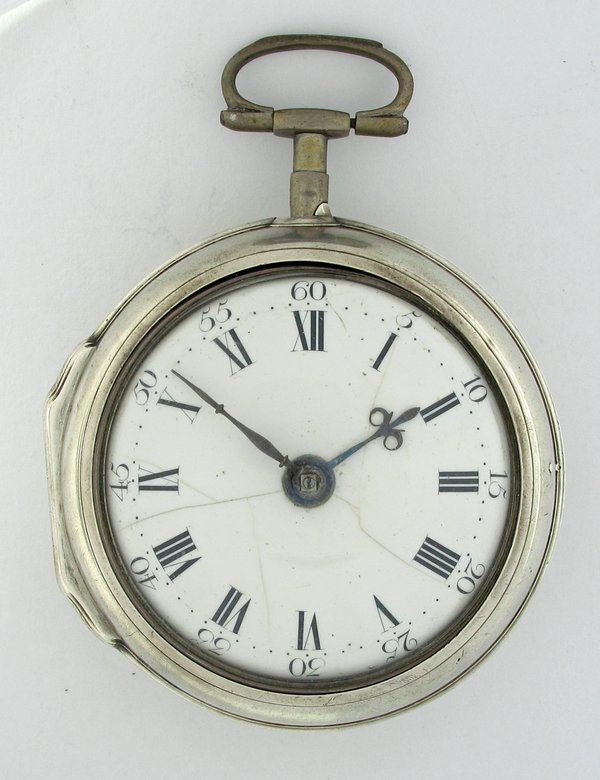
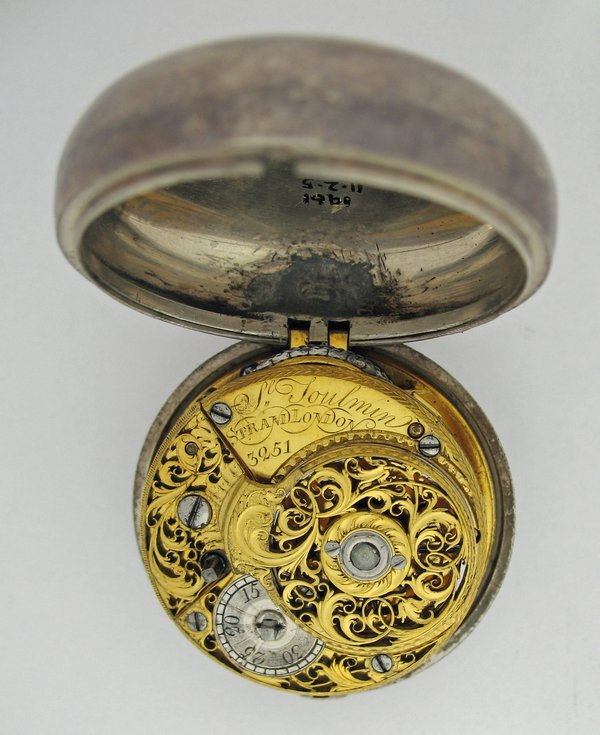
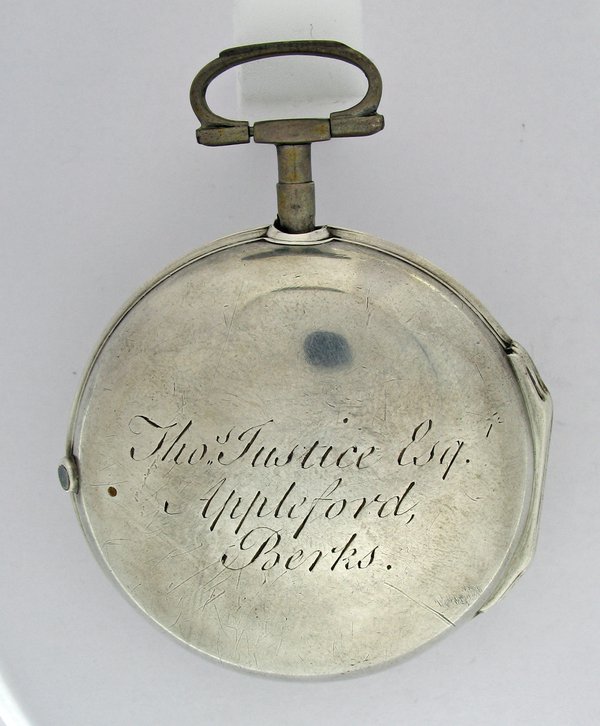
Further information about an owner of the watch appears on an advertising paper inside the case. The information on the paper tells us that by 1822 the watch was in Abbingdon, in Berkshire, where it was looked at by Thomas Ansell near the Abbey – presumably a routing clean and re-oil. We are fortunate that an inscription on the reverse of the paper reveals the name of its owner at that time as Mr. Thomas Justice, Appleford.

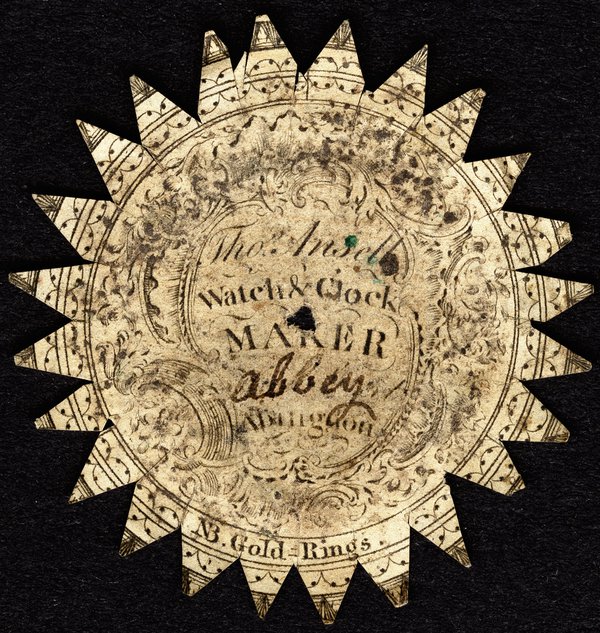
On Wednesday 20th January 1830, a group of properties in Appleford, Sutton Courtney, formerly owned or rented by Thomas Justice were auctioned at the Crown & Thistle in Abingdon. It may be that Thomas was trying to realise some cash. On Monday 8th February 1830 a petition was heard at court in Portugal Street, Lincolns Inn Fields, London, concerning the Insolvency of one Thomas Justice, late farmer of Appleford.
In the church of St. Peter & St. Paul in Appleford is the following memorial:-
'In a vault near this church lie interred the remains of Thomas Justice Esquire, late of this parish who departed this life on the fourth day of January 1843 aged 54. Also of Martha Justice reliat of the above who departed this life on the 8th day of September1848 aged 59. Also of Thomas Francis Justice, Esquire, son of the above. Who departed this life on the 13th day of January 1847 in the 28th year of his Age.'
There’s a lot more to say about the Justice family of Appleford but it’s amazing what can be found on the internet in a very short time.
As one journey ends another begins
This post was written by Matthew Read
It was with some sadness (weep!) that postgraduate and MA students Francoise Collanges and Brittany Cox recently fled, or rather graduated from the West Dean nest. Over the summer period they completed their practical MA projects and accompanying 12,000 word theses.
Both Francoise's work in the study of early electro-magnetic clocks and Brittany’s in the materials used inside automata that smoke (!) will undoubtedly add value to the body of knowledge in these specialist fields. During the process, a lot of fun, blood sweat and tears ensued. Result! We wish them both well.
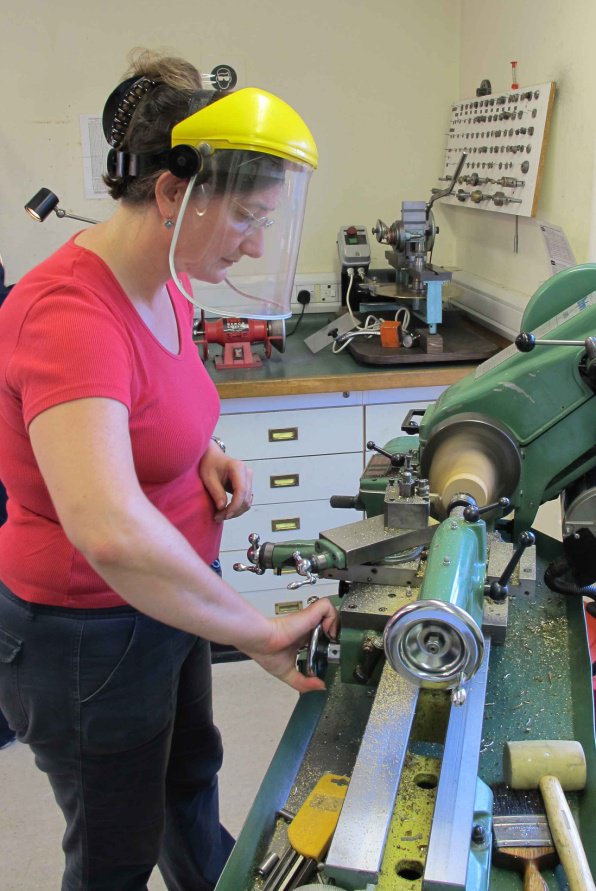
Early October saw the intake of new students and the welcome back of those returning. All students new to the clocks programme at West Dean begin their long journey through horological bench craft skill by designing and making their very own clock.
As a beginning, clockmaking embraces so many of the materials, tools, techniques required for later life as conservator restorers. The world of turning, soldering, filing and scraping, geometry, mechanics and a little mathematics thrown in is a demanding one, and interestingly, the outcomes from what is outwardly a uniform process, are as diverse as the students themselves. Christmas should see trains and frames completed, entire clocks by awards day 2013.
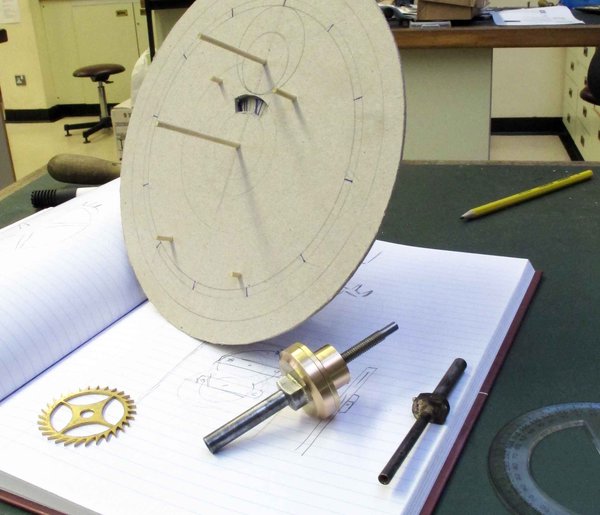

Returning students on Diploma and Postgraduate programmes are working on historic clock projects. These span sensitive cleaning and conservation of a mystery clock by Houdin, through the repair of an imposing ormolu mounted mantel clock signed Cellier, to the reinstatement of verge and crownwheel escapement to an early eighteenth century spring clock.
Many of the projects are multi-media and therefore require interdepartmental liaison in the conservation and repair processes. Never a dull day in clockmaking.
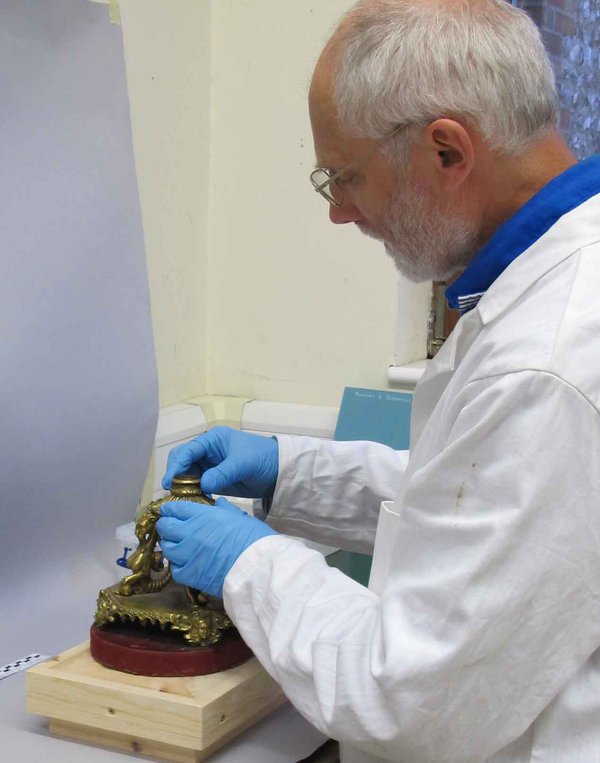
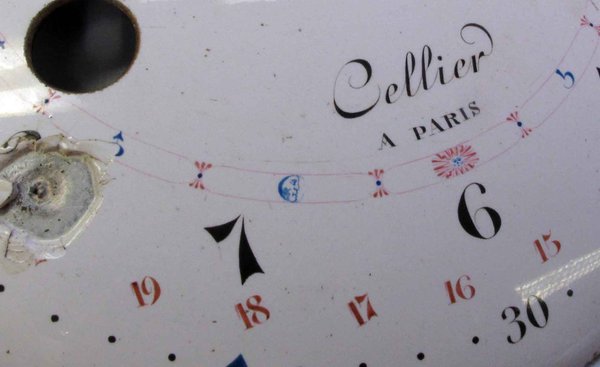
As always, lots to do, lots to see.

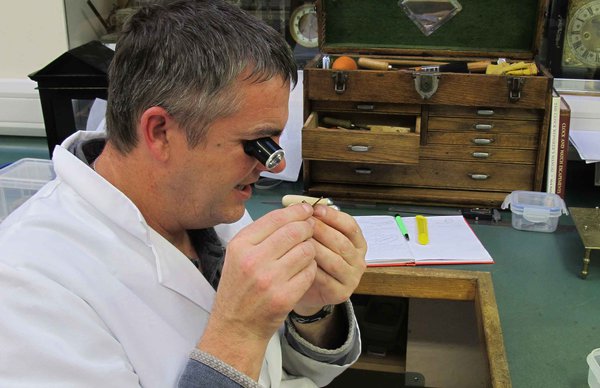
West Dean holds its Open Day on Saturday 10th November 2012. All welcome. See www.westdean.org.uk
Surprising old-timers
This post was written by James Nye
Several of us field enquiries that come from all over the globe, addressed to the secretary at Ticehurst, and which predictably often turn on the issue of ‘How much is my clock worth’, or ‘I found this in the attic. What is it?’
We don’t do the Antiques Roadshow valuation bit – we leave that to our good friends at places like Bonhams and Christies – they know markets.
But if there’s a bit of a challenge in working out who made something, or where, or even why, the AHS team fires up. On the fringes of timekeeping, all sorts of things can crop up, like the ‘pipsqueak’ system in fighter planes, which David covered back in April.
On a theme from my last post (bombing), a colleague and I found ourselves swapping pictures of mine timers recently – mine’s a Mark IV (did you see what I did there?) but his is a splendid Mark I – giving 44 days and 23 hours of delay – all part of the dirty tricks played by both sides in the Second War with secondary and much delayed explosions catching rescue workers.
The movements of these British timers are of the excellent ‘Reform’ type, from Schild, which featured in David Read’s wonderful journal article on the electric remontoire.
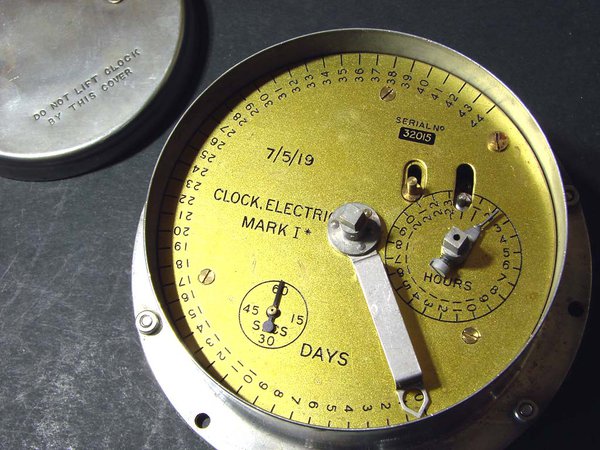
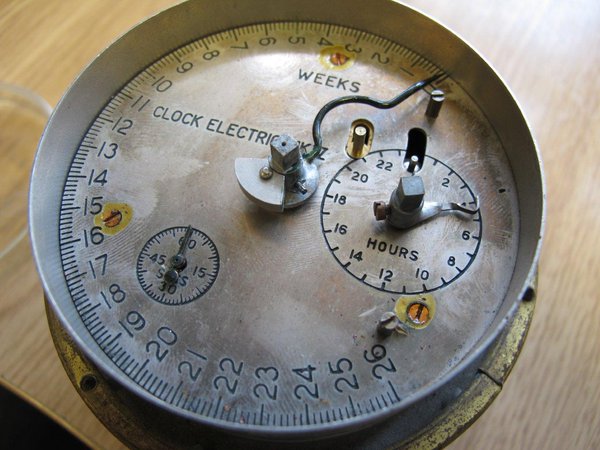
A recent enquiry offered another object lesson in technology linking distant people and allowing the discovery of deeply hidden information. A Ticehurst correspondent (location at first unknown) asked about an electrical clock movement, admitting ‘it is in very bad shape’ and ‘the only name partially visible on the clock is PATENT K. HEIDECG’.
Settling down with a sandwich, and priding myself on an ability to navigate patent databases, I was on the case in seconds, but as I came to the end of my lunch, the crumb-filled keyboard had yielded no answer. Dispirited, I wrote back and asked for pictures.
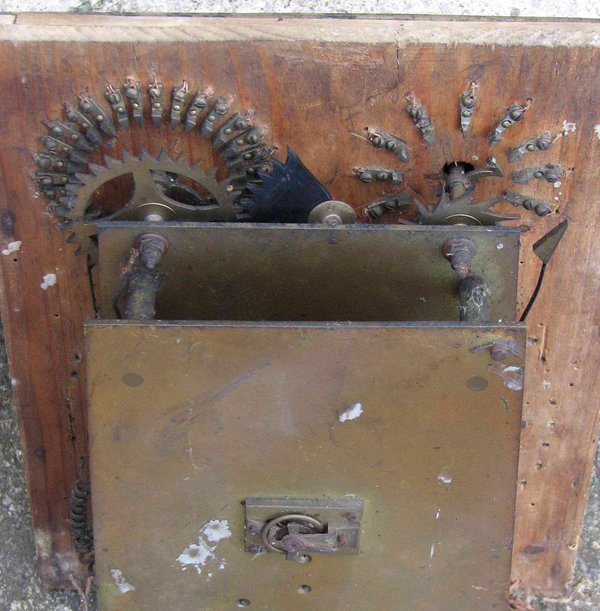
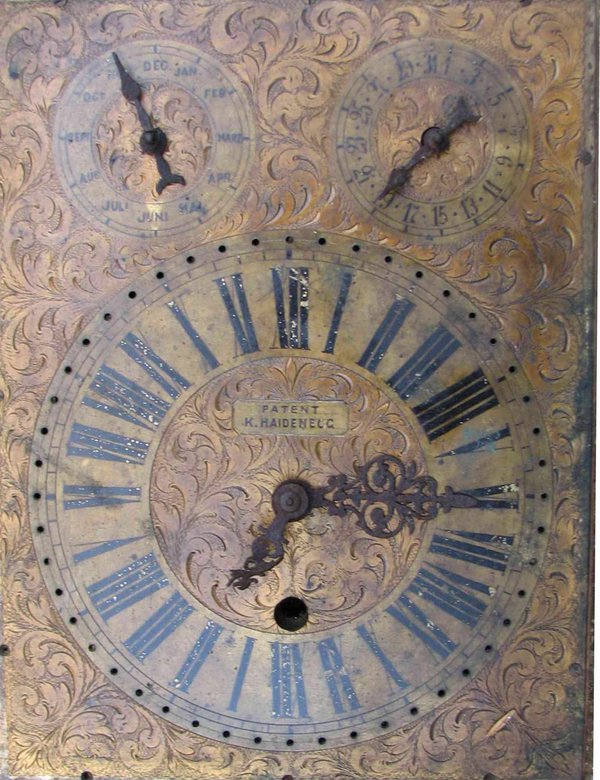
These came, and within moments we had our quarry snared with a one-for-one map to a patent taken out in 1896 by a postmaster – Mr Konstantin Haidenegg – from Pakrac in (what was then) Hungary, for an unusual timer, or signal clock.

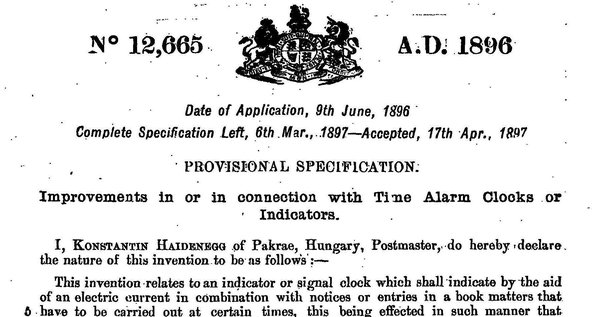
There was a Swiss patent as well, and no doubt a local Hungarian version first of all, but that has not been digitalised yet. However, all this was much to the delight of our correspondent, who lives in – wait for it – Pakrac (now in Croatia)!
No longer Hungary, and no longer hungry, my lunchtime wanderings weren’t wasted and we had another satisfied customer with a local object identified and destined for preservation. Job done!